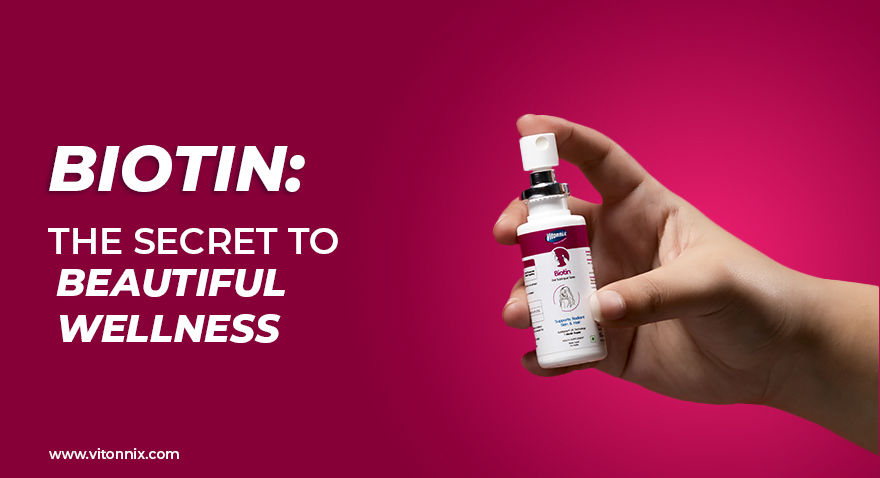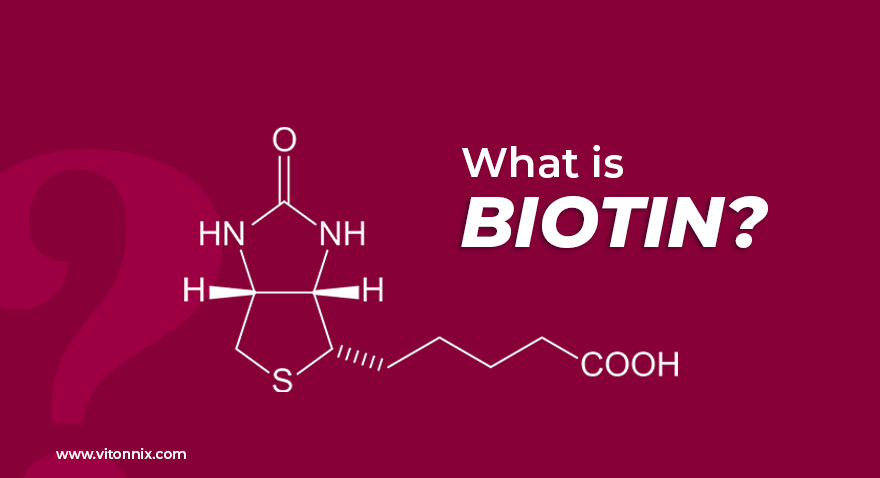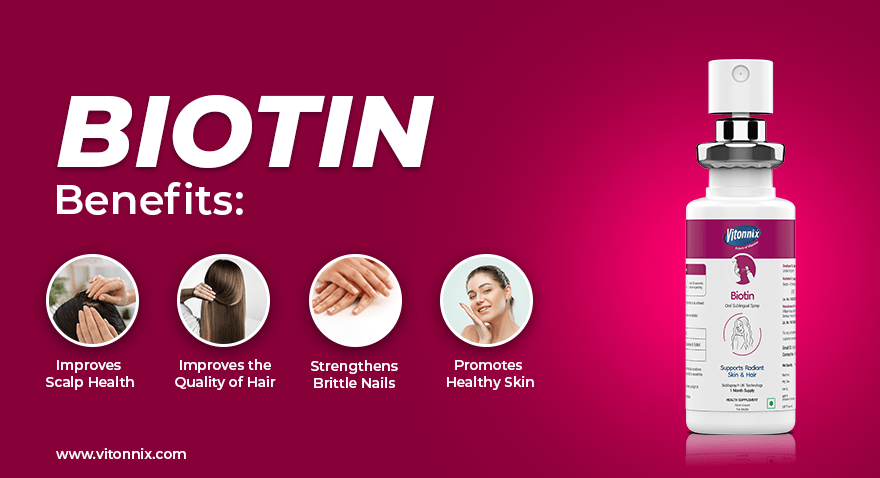Biotin: The Secret to Beauty & Wellness
Biotin: The Secret to Beauty & Wellness

The search for that bright glow and healthy hair has led us to look into the potential of biotin in a society where well-being and beauty are valued more than ever. B-vitamin biotin has gained attention lately for its amazing impact on human wellness and beauty.
It is difficult to overlook the growth in popularity of biotin supplements as we navigate through a variety of health and beauty routines. This understated vitamin is essential for strengthening and preserving the health of our hair, skin, and nails.
But what exactly is biotin, and why is it said to be the key to beauty and good health? We’ll discuss, the benefits and appeal of biotin in this blog that follows, revealing how this affordable nutrient may help you achieve your full potential as a healthier, more attractive person.
What is Biotin?
Biotin is a water-soluble B vitamin known as Vitamin B7. Biotin plays an important role in the functioning of enzymes responsible for metabolizing fats and carbohydrates, influencing cellular growth, and contributing to synthesizing amino acids necessary for protein formation.

Given these attributes, it’s no surprise that Vitamin H is often recommended as a supplement for those experiencing issues such as brittle nails and hair loss. Furthermore, in addition to other antioxidants, biotin can help detoxify, promoting improved immunity and radiant skin.
The Role Of Biotin In Beauty and Wellness
Biotin has drawn a lot of interest recently, not just as a necessary nutrition but also as a natural approach to improving the way someone looks. Let’s explore how biotin adds to our general health and beauty.
Skin Health and Biotin:
Skin, being the body’s biggest organ, represents an individual’s general health and well-being. The following are some ways that biotin benefits healthy skin:
Nourishing Skin Cells: Biotin plays a key role in the growth and maintenance of healthy skin cells. Fatty acids are necessary for skin regeneration and moisture retention, and they help in their production.
Fighting Dry Skin: Biotin helps to make ceramides, a kind of lipid that contributes to the formation of the skin’s protective barrier. This barrier stops water loss, hydrates the skin, and guards against dryness.
Acne Management: Although more study is needed in this area, several studies have found that biotin may be able to control acne by reducing skin inflammation.
Biotin and Healthy Hair:
Our hair is frequently regarded as our crowning jewel, and biotin has a well-established effect on hair health:
Hair Growth: Keratin, a protein that makes up the bulk of our hair, is produced more readily when hair follicles get a boost and biotin is present.

Hair Strength: Biotin helps the hair shaft become stronger, which reduces the likelihood of breakage, split ends, and damage.
Hair Texture: Regular biotin consumption is linked to enhanced shine and better hair texture.
Strong Nails and Biotin:
Additionally, biotin is important for healthy nails:
Nail Strength: Biotin helps to strengthen the structure of keratin in nails, making them stronger and less likely to break.
Preventing Nail problems: A biotin deficit can cause thin, brittle, or slowly growing nails, among other nail problems. Consuming enough biotin helps avoid these problems.
You may improve your general well-being and appearance by including biotin in your daily routine, either through a balanced diet or supplementation.
Signs of Biotin Deficiency
Biotin deficiency may show up in a range of serious signs. Here are the top five biotin deficiency signs to watch out for:
Skin Issues: Initial signs of biotin deficiency include skin irritation or rashes around sensitive regions including the eyes, nose, mouth, and genital area. These unpleasant signs could occur from a biotin deficiency because it is essential for keeping healthy skin.
Nail issues: A biotin deficiency can often be detected by brittle or missing nails. This vitamin is crucial for growing strong, healthy nails, and deficiency can lead to brittle, easily breakable nails.
Hair Concerns: A lack of biotin can result in hair thinning or loss. Hair quality can be affected by a biotin deficiency since it is necessary for both hair growth and strength.
Dry, Scaly Skin: Another typical sign of biotin deficiency is dry, scaly skin. Lack of this vitamin can lead to dry, scaly skin since it is necessary for maintaining skin moisture and health.
Weakness and Fatigue: A biotin deficit is linked to fatigue and weakness. Low amounts of this B vitamin, which is involved in energy synthesis, can cause fatigue and a lack of enthusiasm.
It’s important to identify these signs so that biotin deficiency may be treated right away. Ensuring a balanced diet that includes biotin-rich foods or supplements when necessary can help keep optimal levels of this important vitamin, promoting general health and energy.
Biotin Supplements
While biotin is available in various supplement forms, when it comes to achieving the most effective results, sublingual spray stands out as the best choice. Vitonnix’s sublingual spray offers a convenient and highly effective way to support healthy skin, hair, and nails.
Vitonnix Biotin Sublingual Spray is a new technique to absorb biotin into your bloodstream and is your ticket to radiant beauty. This method ensures fast absorption and maximum efficiency. Each spray delivers a precise dosage of biotin, accelerating the process of healthier hair, skin, and nails. It’s ideal for all ages, delicious to taste, and provides the benefits of biotin efficiently.
Vitonnix Biotin Sublingual Spray, an easy solution to increase your biotin intake, will help you discover the key to radiant beauty and active health.
How To Choose The Right Biotin Supplement?

To get the results you want, you must pick the most effective biotin supplement. Here are some tips to consider:
Dosage: Look for supplements with the right amount of biotin. Each spray of the Vitonnix Biotin Sublingual Spray has a precise dose. Always ask a healthcare professional before picking a high-dosage supplement.
Form: Biotin supplements come in a variety of forms, including capsules, soft gels, gummies, and sublisprays. Pick one that complies with your preferences and dietary needs. Sublisprays are a great choice and also a tasty option.
Ingredients: Check the ingredient list for additions or allergens. Ideally, your biotin tablet should contain minimal extra ingredients.
Bioavailability: Different forms of biotin are more or less bioavailable. Biotin linked to protein (as found in food) tends to be more soluble compared to biotin in its free form.
Consult a Professional: If you’re not clear about which biotin supplement is best for you, speak with a nutritionist or a healthcare professional. Based on your goals for health and any current medical issues, they can advise you on the best course of action.
Conclusion
Biotin is a key nutrient that promotes healthy skin, hair, and nails, while also benefiting your metabolism and overall fitness. Ensuring you meet your biotin requirements is crucial, given its proven beauty-enhancing properties. Vitonnix Biotin Sublingual Spray is your go-to choice to unlock these benefits. With its purity and potency, it offers a unique way to boost your biotin intake, helping you both look and feel your best. It’s simple to use – just spray it under your tongue as directed on the packaging for rapid absorption. Experience the remarkable benefits of Vitonnix Biotin Sublingual Spray for yourself. Click here to make your purchase and make your skin, hair, and nails healthier.






